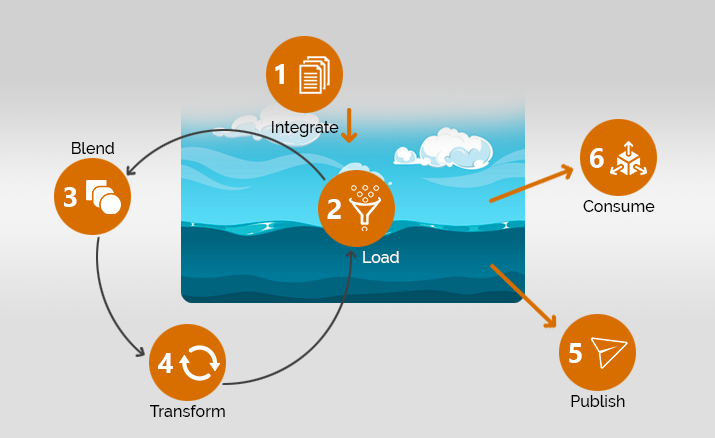Need for Data Engineering
In our everyday life, we are producing a massive amount of data knowingly or unknowingly. This happens due to several actions we perform every day, including the calls we make, the messages we send, our transactions, the videos we watch, how we interact on social media, and the websites we visit. This data can be stored as Structured or Unstructured. However, converting this raw data into valuable information might not be that simple. Organizations need to create, store, access, and analyze this data according to business requirements to make the right decisions via actionable insights.
The focus is often given to data analytics, but it is critical to ensure that the foundation of data is correct. To achieve that, data engineering plays a vital role in bringing the data together from across the sources. In this blog, we will deep dive into data storage, a fundamental aspect of data engineering. While talking about data storage and big data, popular options in Data Warehouse and Data Lake resonate across industries, but the emergence of Data Lakehouse will play a pivotal role in the upcoming times.
Data Warehouse, Data Lake, and Data Lakehouse are technologies that serve different use cases with some overlap. However, Data Warehouse and Data Lake are the building blocks of Data Engineering. This blog will break down the differences between Data Warehouse, Data Lake, and Data Lakehouse to find out which one is best suitable for a given business and throw light on the emerging concept of Data Lakehouse, which orchestrates the best of both Data Warehouse and Data Lake worlds.
What is Data Warehouse?
Data Warehouse is a technology that aggregates pre-processed data from one or more sources, including marketing, sales, and finance. Here, the data structure is well defined, optimized, and ready to be used for analytical purposes.

Where is Data Warehouse Better Suited?
When the business is clustered, we might need to summarize data from all the clusters and concentrate more on quality, maintenance, and accuracy. Since the data needs to be more structured, a Data Warehouse is better suited.
Examples of Industries where Data Warehouse is better suited: Retail, Telecom.
What is Data Lake?
A lake is a container or reservoir where inflow is not restricted to a single source. Similarly, Data Lake is a storage environment where you can store/dump your data as it is, without worrying whether it is structured or unstructured data and about its storage capacity. It helps the organization analyze the data at any scale (dashboards, visualizations, machine learning) to make accurate decisions.

When is a Data Lake preferred over a Data Warehouse?
In typical scenarios like social media and media industries, an organization might be in a situation to store both structured data (user id, passwords, personal information) and unstructured data (including images, audio, video). In this case, data warehouse is generally not an ideal model. Instead, data lakes allow for a combination of structured and unstructured data, which tends to be a better fit for these organizational needs.
Key Differences between Data Warehouse and Data Lake
| Data Warehouse | Data Lake | |
| Data | It contains highly structured data that is cleaned, pre-processed, and refined | It contains unstructured, semi-structured, or structured data with minimal processing |
| Size | Size goes up to terabytes | Size may vary between petabytes |
| Use case | As Data Warehouse contains historical and relational data, it will be helpful for Business Intelligence (BI) and reporting purposes | The data stored in a Data Lake can be used for Machine Learning, Streaming, Real-time analysis, and in the field of Artificial Intelligence (AI) |
| Pricing | Slightly more expensive | Comparatively low in terms of cost as we don’t pay much attention to structuring the data |
Data Lakehouse: Combining the Best of Both Worlds
Data Lakehouse is a combination of Data Warehouse and Data Lake. Before diving into the details of Data Lakehouse, let us investigate the limitations of Data Warehouse and Data Lake first.
| Data Warehouse | Data Lake |
| Doesn’t support unstructured data | Poor BI support |
| Extra reporting work | Integration issues |
| Limited support for streaming | Poor performance |
To overcome the limitations of Data Warehouse and Data Lake, we bring Data Lakehouse into action.

Data Lakehouse is a new term in modern data platforms, where we can embed the features of Data Lake into Data Warehouse. It combines the flexibility, pricing, and storage capacity of Data Lakes with the structure management of Data Warehouses, enabling several features like Machine Learning, streaming, and visualization.
Data Lakehouse Tools: Data Bricks with Azure or GCP, Snowflake, and AWS Data Lake House solutions.
Key features of Data Lakehouse:
● Data Governance and schema
● ACID (Atomicity, Consistency, Isolation, and Durability) support
● Easy enablement for BI tools with source data
● Separation of storage and compute
● Support for all data types in structured, semi-structured, and open data formats
● Easy workload monitoring and complete streaming
Examples of Industries where Data Lakehouse can be implemented: Telecom and Banking domain, which has huge telemetry and IoT data volume.
Data Engineering is the Foundation for Authentic Analytics
In the late 1980s, we saw the emergence of Data Warehouse, where rigid schema was the go-to model as the need for structured data was critical during those times. However, by 2010, the industry saw a dramatic shift to Data Lake because the need for managing unstructured data increased rapidly due to the multifold growth in social media and text analytics. During that time, there were relaxations to the rigid schema as the unstructured data was schemeless. Now, post-2020, data engineers are moving towards Data Lakehouse, which offers the best of structured and unstructured data forms. Here, the benefits of both Data Warehouse and Data Lake are brought together to use all forms of data.
Data Warehouse, Data Lake, and the emerging Data Lakehouse are promising options for exhaustive data storage and set a strong foundation for accurate data analytics. Even though Data Lakehouse is considered an alternative to Data Warehouse and Data Lake, it is still in its emerging phase and has its limitations. However, top organizations have already started experimenting on this platform, targeting a better future with best-in-class Data Engineering. Establishing a solid foundation in data is critical for successful analytics and ensuring the right data engineering strategy makes much difference.
Partner with Us
Our expert Data Engineering team at LatentView Analytics helps organizations monetize and maximize the value of their data by taking a curated approach. We build a strong foundation of data and generate insights from data mining. Our goals are to tackle critical issues that prevent businesses from exploiting opportunities to scale and transform themselves into data-savvy competitors. Get in touch with us at marketing@latentview.com to know more.





